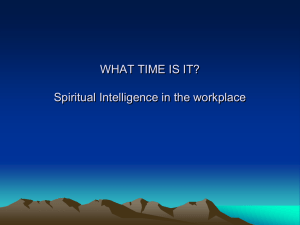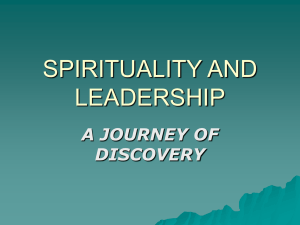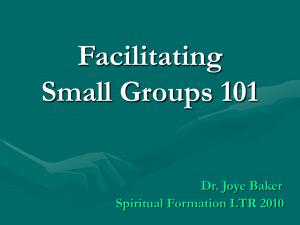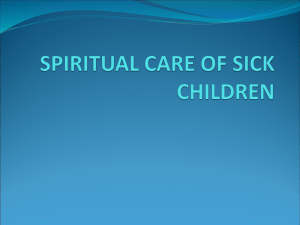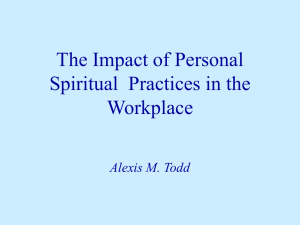Meaning-Centered Counselling and Therapy
advertisement
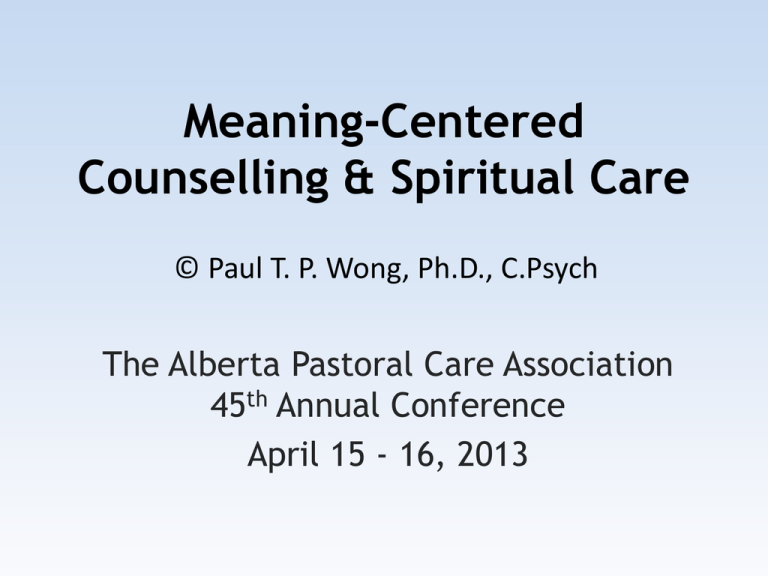
Meaning-Centered Counselling & Spiritual Care © Paul T. P. Wong, Ph.D., C.Psych The Alberta Pastoral Care Association 45th Annual Conference April 15 - 16, 2013 Overview • The general characteristics of Meaning Therapy (short name of MeaningCentered Counselling & Therapy) • The basic the principles and practices of Meaning Therapy • Meaning Therapy & Spiritual Care Wong’s Meaning Therapy • It evolved from logotherapy and cognitive behavioral therapy. • It is part of the third wave of psychotherapy which involves powerful new concepts such as acceptance, commitment, meaningmaking, and re-storying. From Logotherapy to Meaning Therapy • Logotherapy was an adjunct to psychotherapy and medical practice. • Meaning Therapy is an integrative psychotherapy. • Meaning Therapy elevates the motif of meaning into a symphony. • Meaning Therapy is more anchored in empirical research. Existential Positive Psychology (EPP) • By definition, EPP integrates the positive potentials & negative potentials of human existence. • The main thrust of EPP is the positive transformation of life as a whole. Sources of Positivity • God is the source of all blessings • Life itself is a gift from God • The human potential for growth, spirituality, & goodness • There is beauty, truth, & kindness in the world • Positive emotions & traits Sources of Suffering • Natural disasters • Man-made disasters • Existential anxieties • Spiritual deadness • Inner brokenness • Breakdown of relationship • Physical illness & pain Dimensions of Suffering (Mak, 2007) • Physical – physical symptoms & pain • Psychological – helplessness, hopelessness, & uncertainty • Social – isolation & relational conflict • Spiritual – lack of meaning in life The Challenge of Meaning Therapy • How to tap into sources of positivity to transform or transcend negativity & suffering • How to capitalize on the human capacity for spirituality & meaning seeking/making to achieve personal & social transformation The Motto of Meaning Therapy Meaning is all we have; relationship is all we need. • Human beings are meaning seeking/making beings, living in a world of meaning. • Relationship is all we need to help clients: Relationship itself heals. How to relate to self & others is the basis for healthy living. Every problem exists in a relational network. Meaning as the Central Construct Meaning Therapy integrates different approaches of psychotherapy with meaning as the central construct. Cognitive Meaning – Cognitive Behavioural Therapy Existential/Spiritual Meaning – Existential Therapy & Spiritual Care Narrative Meaning – Narrative Therapy Unconscious Meaning – Psychoanalytic Therapy Cultural Meaning – Cross-Cultural Therapy The Defining Characteristics of Meaning Therapy • • • • • • • Integrative/holistic Existential/spiritual Relational Positively oriented Multicultural Narrative Psycho-educational Sources of Meaning According to Wong (1998), there are 8 sources of meaning and the good life. 1. Achievement 5. Relationship 2. Acceptance 6. Religion 3. Transcendence 7. Fairness 4. Intimacy 8. Positive emotions Definition of a Meaningful Moment 1. It is deeply felt – It touches your emotions in a deep and lasting way. More than a fleeting feeling, it reaches your innermost being. 2. It is deeply processed – It involves deeper layers of meaning beyond the factual and superficial. 3. It is enlightening – It provides a solution to some puzzling problems or leads to some new discovery. 4. It is transforming – It enriches your life, changes your life’s direction, or restores a sense of purpose and passion to your life. The Meaning Mindset 1. Life has intrinsic meaning and value. 2. My ultimate purpose is self-transcendence. 3. I can live at a deeper level by detecting the meaning & significance of any situation. 4. I can live at a higher plane by serving a higher purpose & being attuned to the transcendental realm. 5. I can live fully by integrating my potentialities with my vulnerabilities moment by moment. Life Orientation Scale 1. I can find something meaningful or significant in everyday events. 12345 2. There is a reason for everything that happens to me. 1 2 3 4 5 3. There is no ultimate meaning and purpose in life. 1 2 3 4 5 4. There is no point in searching for meaning in life. 1 2 3 4 5 5. No matter how painful the situation, life is still worth living. 1 2 3 4 5 6. The meaning of life is to “eat, drink and be happy”. 1 2 3 4 5 7. What really matters to me is to pursue a higher purpose or calling regardless of personal cost. 1 2 3 4 5 8. I would rather be a happy pig than a sad saint. 1 2 3 4 5 9. I am willing to sacrifice personal interests for the greater good. 12345 10.Personal happiness and success are more important to me than achieving inner goodness and moral excellence. 1 2 3 4 5 Principles of Relationship • Relationship is more than therapeutic alliance • Relationship is more than relational therapy (overcoming relational deficits) • The principles of relationship include 1. Presence 2. Rogerian principles 3. Learning new patterns of relating The Therapeutic Presence • Who we are is more important than what we say. • Rogers’ three pre-conditions need to be the personal characteristics of counsellors. • Personal wholeness of the therapist is important. • The messenger is the message. • The therapist is the therapy. • The counsellor brings a healing presence. • The counsellor models meaningful living. • The counsellor practices counselling by osmosis. Rogerian Principles Healing through Relationship • New patterns of relating based on trust & authenticity • The dynamic of moment-to-moment interaction provides windows for therapy • Accepting resistance and negative reaction as part of the healing process Healing through Relationship (Cont.) • The ground rule of respect and caring applied to both the therapist and the client • Recognize that each individual is both unique and similar • Empower the client to discover his or her own path, no matter how painful Different Levels of Relating • At the social level, two strangers get to know each other in a trusting and non-judgmental environment • At the existential level, two human beings share their common humanity and their authentic selves • At the professional level, the therapist is responsible for achieving desirable therapeutic goals Therapeutic Goals • To awaken the client’s sense of responsibility and meaning • To achieve a deeper understanding of the problem from a larger perspective • To help the client discover his or her true identity and place in the world • To help the client pursue what really matters in life Therapeutic Goals (cont.) • To develop the client’s full potential • To make life better for self & others • To transform a victim’s journey into a hero’s adventure • To discover meaning and hope in boundary situations • To transform negatives into positives through meaning seeking/making The Art of Questioning • • • • • • Responsibility questions Choice questions Trajectory questions Quest questions Magic questions Diagnostic questions Eight Enduring Existential Questions 1. Who am I? 2. What do I want? What really matters in my life? 3. How and where can I find happiness? 4. What should I do with my life? 5. How can I avoid making the wrong choices? 6. Where do I belong? Where is my home? 7. What is the point of all my striving? 8. What will happen to me after I die? Intervention Strategies 1. The PURE Strategy 2. The ABCDE Strategy 3. The Double Vision Strategy 4. The Dual Systems Strategy The PURE Principles The four treasures of Meaning Therapy: Purpose – the motivational component Understanding – the cognitive component Responsible action – the behavioral component Enjoyment – the affective component The ABCDE Strategy • Accept and confront the reality – the reality principle • Believe that life is worth living – the faith principle • Commit to goals and actions – the action principle • Discover the meaning and significance of self and situations – the Aha! principle • Evaluate the above – the self-regulation principle Acceptance • Accepting what cannot be changed • Accepting reality, limitations, loss, trauma, existential givens • Acceptance does not mean giving up or resignation • Confronting one’s worst fears with courage and tragic optimism • Transcending and transforming the tragedy Levels of Acceptance • Cognitive acceptance • Emotional acceptance • Realistic acceptance • Integrative acceptance • Existential acceptance • Transcendental acceptance • Transformative acceptance Belief • Affirming one’s ideals and core values • Believing in the intrinsic value and meaning of life • Believing in an Ultimate Rescuer or Higher Power • Believing in the eventual triumph of good & justice Commitment •Moving forward and carrying out one’s responsibility with determination •Doing what needs to be done regardless of feelings or circumstances •Striving to fulfill one’s responsibility no matter what •Enduring hardship and pain for a worthy cause •Practicing the PURE principle •Pursuing realistic goals •Re-authoring one’s life story Discovery • Learning something new about the self and life • Digging deeper, exploring farther, and searching higher • Discovering one’s hidden courage and strength • Discovering the power of faith and spiritual resources • Grasping the complexities of life and people Evaluation •Savoring small successes or re-assessing one’s progress •Feeling relief that the worst is over •Savoring the moments of small success •Reflecting and reviewing one’s life •Receiving feedback from others •Conducting assessments and making adjustments The Double Vision Strategy Meaning-mindset Meaningful moments PURE Framework Sources of meaning Frankl’s 3 basic tenets and values of meaning Avoidance Approach A Dual-Systems Model of Living the Good Life Seeking what is meaningful Enjoying the present moment The Good Life Transforming what is negative Letting go © Paul T. P. Wong Aspects of Spirituality • Pertain to ultimate meaning and purpose • Discover a sense of meaning, calling, & significance • Involve certain spiritual practices • May involve a set of religious beliefs & rituals • Believe in a Higher Being and a spiritual reality • Experience sacred moments • Cultivate a transcendental connection • Seek spiritual direction & formation An Instrument Approach to Spiritual Care (Based on what you say and do with patients) • Addressing patients’ spiritual needs • Addressing patients’ existential needs • Taking a spiritual history of patients • Incorporating appropriate spiritual practices • Involving chaplains and spiritual leaders • Involving the appropriate faith community A Transformative Approach to Spiritual Care (Based on what you say and do with patients) • The healing silence – listening to the inner voice • The healing touch – touching the heart & soul • The healing connection – establishing an I-You relationship • The healing presence – providing a caring, compassionate presence • The healing process – nurturing spiritual growth Current Trends in Spirituality and Health • Breaking down the barriers between the medicine, psychotherapy, and religion • The inadequacy of a technological, curebased medical model • Increasing recognition of the role of spirituality in health care Current Trends (cont.) • No medication for broken hearts or wounded souls • The need for compassionate care (Puchalski, 2001) • The need for spiritual care and spiritual transformation What is Compassionate Care? • “Serving patients may involve spending time with them, holding their hands, and talking about what is important to them” (Pychalski, 2001) • “The word compassion means ‘to suffer with.’ Compassionate care calls physicians to walk with people in the midst of their pain, to be partners with patients rather than experts dictating information to them” (Puchalski, 2001) A Holistic Approach to Health Care • The person is dimensional and unified • Wong’s schematic presentation • Caring for physical, psychological, existential, and spiritual needs • Cure is not possible for many illnesses • Healing is possible in all illnesses • The core of healing is spiritual Spirituality & Health • Spiritual hunger: A universal human need • The biological basis of spirituality • Spiritual being vs. Spiritual awakening • Spirituality vs. Religion • Intrinsic vs. Extrinsic religion • Part of the medical curriculum The Role of Faith and Spirituality in Health • Prayer contributes to healing and recovery • Faith enhances quality of life, hope, and happiness • Religious beliefs affect medical decisions • Spiritual beliefs facilitate death acceptance • Coping with chronic pain, disability and terminal illnesses • Addressing existential issues • Making it an integral part of holistic care Empirical Findings on the Benefits of Faith • • • • • • • • Greater longevity Higher quality-of-life score Lower blood pressure Fewer cardiovascular problems Fewer cases of depression & anxiety Better immune functioning Faster recovery from surgery Healthy life style Be a Spiritually Transformed Healer • Understanding your own spiritual needs • Nurturing your own spirituality • Treating spirituality as part of personal & professional development • Caring for the wounded healer • Viewing the world from a spiritual lens • Transforming spiritual care into Divine care Conclusion • Meaning is a key component in spiritual care for cancer patients. • Meaning therapy is integrative. It focuses on the human capacity for meaningseeking & meaning-making.


